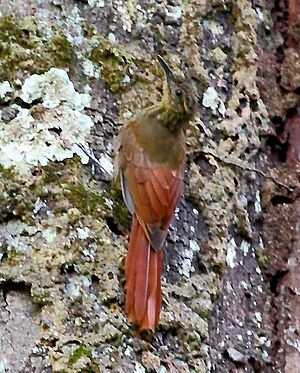Northern long-tailed woodcreeper facts for kids
Quick facts for kids Northern long-tailed woodcreeper |
|
|---|---|
 |
|
| at Presidente Figueiredo, Amazonas state, Brazil | |
| Conservation status | |
| Scientific classification | |
| Genus: |
Deconychura
|
| Species: |
longicauda
|
 |
|
| Range of the long-tailed woodcreeper sensu lato; see the Taxonomy and Distribution sections for more | |
The northern long-tailed woodcreeper (Deconychura longicauda) is a fascinating bird that lives in the forests of South America. It belongs to a group of birds called woodcreepers, which are part of the ovenbird family known as Furnariidae. You can find this bird in countries like Brazil, French Guiana, Guyana, and Suriname.
Contents
About Its Name and Family
Scientists sometimes change how they group animals together as they learn more. The northern long-tailed woodcreeper was once considered the same species as two other birds: the little long-tailed woodcreeper and the southern long-tailed woodcreeper.
Some bird experts, like those at BirdLife International and the International Ornithological Committee (IOC), now treat them as separate species. However, other groups, like the American Ornithological Society, still consider them one species. They do note that there are likely at least two or even three different species.
The northern long-tailed woodcreeper itself is considered monotypic. This means it doesn't have any different subspecies within its own group.
What It Looks Like
The northern long-tailed woodcreeper is a medium-sized bird with a slender body. It has long wings and a long tail, along with a thin, straight bill that's not too long.
It measures about 16 to 21 centimeters (6 to 8 inches) long. It weighs around 22 to 36 grams (0.78 to 1.3 ounces). Male birds are usually a bit longer and heavier than females.
Both male and female woodcreepers look alike. Their bodies are mostly olive-brown. Their head and neck are darker with thin, light streaks. The area around their eyes is whitish or a rich buff color.
Their wings and tail feathers are a reddish-brown color. The tips of their main wing feathers are dusky. Their throat can be whitish or yellowish-brown. Their chest is olive-brown with light streaks. The belly and sides are plain olive-brown, and the feathers under their tail are reddish-brown.
Their eyes are brown. The top part of their bill is brownish, and the bottom part is bluish. Their legs and feet are brown. Young woodcreepers look very similar to adults, but their head might be a bit darker.
Where It Lives
You can find the northern long-tailed woodcreeper in the Guianas (French Guiana, Guyana, and Suriname). It also lives in northern Brazil, specifically north of the Amazon River and east of the Rio Negro.
This bird likes to live in different kinds of forests. It especially prefers the inside of humid, untouched forests. However, you might also see it at the edges of forests or in older secondary forests (forests that have grown back after being disturbed).
It mostly lives in terra firme forests, which are on higher ground and don't flood. It can also be found in várzea forests, which are seasonally flooded. They usually live at elevations up to about 500 meters (1,600 feet).
Behavior
Movement
The northern long-tailed woodcreeper stays in the same area all year round. It doesn't migrate to different places.
Feeding
This woodcreeper usually looks for food from about 3 to 20 meters (10 to 66 feet) above the ground. It forages alone, in pairs, or sometimes joins mixed groups of different bird species.
It climbs up tree trunks and vines, often picking or grabbing its prey directly from the bark. Sometimes, it will fly out a short distance to catch insects in the air. We don't know all the details of its diet, but it mainly eats arthropods, which are creatures like insects and spiders. It seems to prefer adult insects rather than their larvae.
Reproduction
Scientists don't know much about how the northern long-tailed woodcreeper breeds. The little information available suggests that its breeding season might be different depending on where it lives.
Vocalization
The song of the northern long-tailed woodcreeper is described as a high, clear, and somewhat sad sound. It goes "pee-pue-tue-tuh---" and gets lower in pitch.
This bird can sing at any time of day, but you'll hear it most often in the early morning and late afternoon. It doesn't sing all the time. If you play a recording of its song, the bird often responds strongly. This suggests that its song is likely used to mark its territory.
Conservation Status
The IUCN (International Union for Conservation of Nature) has assessed the northern long-tailed woodcreeper as a species of "Least Concern." This means it's not currently considered to be in danger of extinction.
Even though it has a fairly large area where it lives, its total population size isn't known. However, it's believed that the number of these birds is decreasing. One of the main threats is that its habitat is being changed and broken up for farming and ranching.
The bird is considered fairly common in most of its range, but it's rare in Suriname. It does live in several protected areas, which helps. However, it seems to be very sensitive to changes in its habitat and needs continuous forest to survive.


